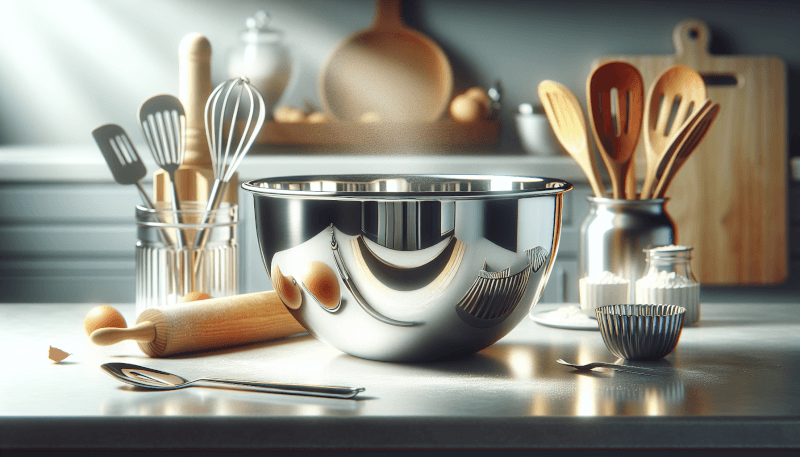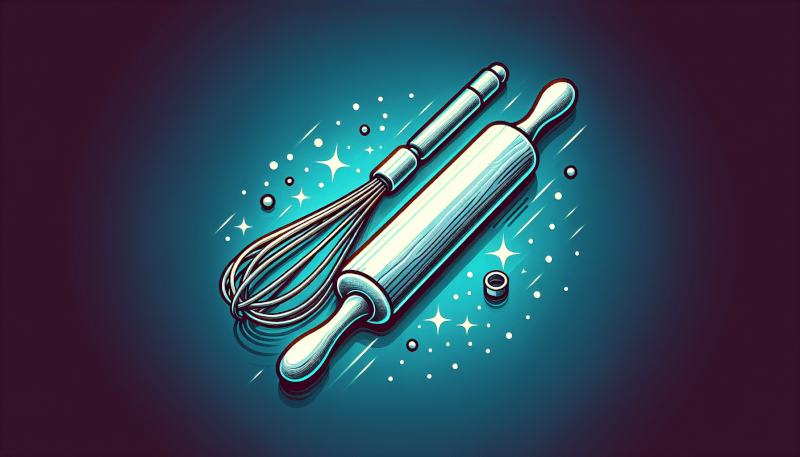Maintaining and caring for your baking tools is essential to ensure delicious and successful baking every time. From spatulas to mixers, each tool plays a crucial role in the baking process. In this article, we will explore some simple yet effective tips on how to properly maintain and care for your baking tools, helping them last longer and maintain their optimal performance. So, grab your apron and let’s dive into the world of baking tool maintenance!
How to Properly Maintain and Care for Your Baking Tools
Baking tools are an essential part of every baker’s kitchen. Whether you’re an amateur baker or a professional pastry chef, it’s important to take proper care of your tools to ensure their longevity and optimal performance. In this article, we will outline the best practices for cleaning, storing, and maintaining various baking tools, so you can continue creating delicious treats without any hassle.
Cleaning Baking Tools
Cleaning Metal Baking Sheets
Metal baking sheets are a staple in any baker’s kitchen. To keep them in tip-top shape, start by removing any excess food or residue from the sheet. Use a non-abrasive scrub brush or sponge and dish soap to clean the surface thoroughly. Avoid using harsh chemicals or abrasive materials, as they can damage the sheet’s finish. Rinse the baking sheet with warm water and dry it thoroughly before storing.
Cleaning Non-Stick Baking Sheets
Non-stick baking sheets require a slightly different cleaning approach to preserve their non-stick coating. Begin by wiping off any loose crumbs or debris from the sheet. Fill a sink or basin with warm water and a mild dish soap. Submerge the baking sheet in the soapy water and use a gentle sponge or cloth to wipe away any remaining residue. Rinse the sheet with warm water and towel dry it or allow it to air dry completely before storing.
Cleaning Silicone Baking Mats
Silicone baking mats are fantastic for ensuring baked goods don’t stick to the pan. To clean a silicone baking mat, remove any excess food or debris by rinsing it under warm water or gently wiping it with a damp cloth. If the mat has stuck-on residue, soak it in warm, soapy water for a few minutes before washing it with a soft sponge or cloth. Rinse the mat thoroughly and air dry it or use a lint-free towel to pat it dry.
Cleaning Rolling Pins
Rolling pins often accumulate dough residue and can be tricky to clean thoroughly. Start by removing excess dough with a scraper or your hands. Then, wash the rolling pin with warm, soapy water, using a soft brush or cloth to remove any stubborn bits. Rinse it thoroughly, ensuring no soap residue remains. Allow the rolling pin to air dry completely before storing it in a cool, dry place.

Storing Baking Tools
Proper Storage for Metal Baking Tools
Metal baking tools, such as baking sheets, cake pans, and wire racks, should be stored in a clean and dry environment. Before storing, ensure that the tools are completely dry to prevent rust or corrosion. Consider organizing them in a designated cabinet or drawer, using dividers or racks to keep them separate and prevent scratching. If space is limited, you can also hang them on hooks or opt for stackable storage solutions.
Proper Storage for Silicone Baking Tools
Silicone baking tools, like mats and molds, should be stored in a cool and dry place away from direct sunlight. Avoid storing them near sharp objects to prevent accidental punctures or tears. Ideally, keep them either in their original packaging or stack them in a neat pile without placing heavy objects on top. This will help maintain their shape and prevent deformation.
Proper Storage for Wooden Baking Tools
Wooden baking tools, including spoons, spatulas, and cutting boards, require special care to avoid warping or cracking. It’s crucial to keep these items away from excessive moisture and heat sources. After cleaning, allow them to air dry completely before storing them in a well-ventilated area. If space allows, hanging them on a utensil rack or placing them in a utensil jar with the handle side down can help maintain their shape.
Sharpening and Maintaining Knives
Choosing the Right Knife Sharpener
A sharp knife is essential for precise cuts and efficient baking. When it comes to sharpening your knives, there are various methods to choose from. Electric knife sharpeners are quick and convenient, providing consistent results. Manual whetstones or sharpening rods are a more traditional option, allowing for more control over the sharpening process. Whichever method you choose, ensure that you follow the manufacturer’s instructions and take proper safety precautions.
Sharpening and Honing Techniques
To sharpen your knife with an electric sharpener, simply insert the blade following the device’s instructions and let it do the work. For manual sharpening, hold the knife at the correct angle (usually between 20 and 25 degrees) and draw the blade across the stone or rod, using light pressure and maintaining consistent strokes on both sides of the blade. Honing your knife with a honing steel regularly can also help maintain its sharpness in-between sharpenings.
Proper Knife Storage
Properly storing your knives is crucial for both safety reasons and maintaining their sharpness. Knives should never be stored loose in a drawer, as this can not only damage the blades but also create a safety hazard. Consider investing in a knife block or a magnetic knife strip to keep your knives organized and secure. If using a knife block, make sure the blades are inserted with the cutting edge facing upward to prevent dulling or chipping.

Maintaining Measuring Cups and Spoons
Cleaning Stainless Steel Measuring Cups
Stainless steel measuring cups are durable and resistant to rust, making them easy to maintain. After each use, rinse the cups with warm water to remove any leftover ingredients. Use a mild dish soap and a soft sponge or cloth to clean the cups thoroughly, paying extra attention to the measurement markings. Rinse them with warm water and dry them with a towel or leave them to air dry.
Cleaning Plastic Measuring Cups
Plastic measuring cups are lightweight and often come in vibrant colors, but they require proper care to avoid staining and warping. Before cleaning, check the manufacturer’s instructions to ensure the cups are dishwasher safe. If they are, place them in the dishwasher’s top rack and use a gentle cycle. If washing by hand, use warm, soapy water and a sponge or cloth to clean the cups thoroughly. Rinse them with warm water and dry them with a towel.
Cleaning Wooden Measuring Spoons
Wooden measuring spoons can be delicate and require special care to maintain their quality. Instead of immersing them in water or washing them in the dishwasher, it’s best to simply wipe them clean with a damp cloth or sponge. Avoid using strong detergents or abrasive materials, as they can damage the wood. After cleaning, dry the spoons immediately to prevent warping or cracking.
Caring for Mixing Bowls
Choosing the Right Mixing Bowl Material
Mixing bowls come in various materials, each with its own advantages and maintenance requirements. Stainless steel bowls are sturdy, non-reactive, and easy to clean. Glass bowls are versatile and allow for easy monitoring of ingredients, but they can be heavy and prone to breakage. Melamine bowls are lightweight and durable, but they can scratch over time. Consider your needs and preferences when choosing a mixing bowl material.
Cleaning Glass Mixing Bowls
To clean glass mixing bowls, begin by rinsing them with warm water to remove any remnants of ingredients. Use a mild dish soap and a non-abrasive sponge or cloth to clean the bowls thoroughly. Pay attention to any stubborn stains or residue, using a baking soda paste for gentle scrubbing if necessary. Rinse the bowls with warm water and dry them with a lint-free towel or allow them to air dry.
Cleaning Stainless Steel Mixing Bowls
Stainless steel mixing bowls are generally dishwasher safe. If washing by hand, rinse them with warm water and use a mild dish soap and a soft sponge to clean the bowls thoroughly. Pay attention to any residue around the edges or on the bottom. Rinse the bowls with warm water to remove any soap residue and towel dry them or allow them to air dry.
Cleaning Melamine Mixing Bowls
Melamine mixing bowls are known for their durability, but they require careful cleaning to avoid scratching the surface. Rinse the bowls with warm water to remove any excess ingredients, then use a non-abrasive sponge or cloth and a mild dish soap to clean them thoroughly. Pay attention to any stains or stubborn residue, using a baking soda paste or a melamine-safe cleanser if necessary. Rinse the bowls with warm water and towel dry them or let them air dry.

Safely Handling Bakeware
Using Oven Mitts and Hot Pads
When handling hot bakeware or ovenware, always use oven mitts or hot pads to protect your hands from burns. Oven mitts provide full hand and forearm coverage, offering excellent protection, while hot pads are more suitable for quick tasks. Invest in high-quality mitts and pads made of heat-resistant materials, such as silicone or quilted cotton, to ensure optimal safety in the kitchen.
Avoiding Thermal Shock
Thermal shock occurs when there is a sudden and drastic temperature change, which can cause bakeware to crack or shatter. To avoid thermal shock, allow the bakeware to cool naturally before placing it under cold water or placing it in the refrigerator. Similarly, do not transfer cold bakeware directly from the refrigerator to a preheated oven. Gradual temperature transitions will help prevent damage and prolong the lifespan of your bakeware.
Properly Greasing and Flouring Pans
Greasing and flouring pans is essential to prevent baked goods from sticking. To grease a pan, use a pastry brush or a paper towel to evenly coat the inside surface with butter, oil, or cooking spray. Pay attention to the corners and edges to avoid any potential sticking. When flouring a pan, generously coat the greased surface with flour, tapping out any excess. This will create a barrier between the pan and the batter, ensuring easy release once baked.
Cleaning and Preparing Cake Pans
After removing the cake from a cake pan, it’s essential to clean the pan properly to maintain its quality. Start by letting the pan cool completely, then rinse it with warm water to remove any loose crumbs or residue. Use a mild dish soap and a non-abrasive sponge or cloth to clean the pan thoroughly, paying attention to any stubborn spots. Rinse the pan with warm water and towel dry it or allow it to air dry before storing.
Preserving Baking Utensils
Cleaning Wooden Spoons
Wooden spoons can absorb flavors and odors, so it’s crucial to clean them thoroughly after each use. Rinse the spoon with warm water to remove any visible residue. Use a mild dish soap and a soft sponge or cloth to clean the spoon thoroughly, paying extra attention to the handle and the back of the spoon. Rinse it with warm water to remove any soap residue and dry it with a towel or leave it to air dry completely.
Cleaning Silicone Spatulas
Silicone spatulas are great for scraping bowls and folding ingredients, but they can accumulate residue over time. Start by removing any excess food with a scraper or your fingers. Rinse the spatula with warm water, then use a mild dish soap and a sponge to clean it thoroughly. Pay attention to any hard-to-reach areas or stubborn stains. Rinse it with warm water and pat it dry with a towel or leave it to air dry.
Cleaning Wire Whisks
Wire whisks can be challenging to clean due to their design, but it’s important to remove any clinging residue. Start by rinsing the whisk under warm water to remove any loose crumbs. Fill a bowl or sink with warm, soapy water and submerge the whisk, swirling it around to loosen any remaining residue. Use a gentle sponge or dishcloth to clean the wire ends thoroughly. Rinse the whisk with warm water and towel dry it thoroughly.
Cleaning Pastry Brushes
Pastry brushes are commonly used for glazing and applying butter or egg washes, and they require proper cleaning to prevent bacterial growth. After each use, soak the brush in warm, soapy water for a few minutes to loosen any dried-on residue. Gently scrub the bristles with a sponge or dishcloth, paying attention to any stubborn spots. Rinse the brush with warm water and dry it by shaking off any excess moisture. Leave it in a well-ventilated area to air dry completely.

Maintaining Electric Baking Tools
Cleaning Stand Mixers
Stand mixers are versatile and powerful, but they require regular cleaning to remove any buildup or residue. Always unplug the mixer before cleaning. To clean the exterior, wipe it with a damp cloth or sponge using mild dish soap. For removable parts, such as bowls, beaters, and attachments, wash them with warm, soapy water. Pay extra attention to any hard-to-reach areas or crevices. Rinse the parts thoroughly and either towel dry them or leave them to air dry.
Cleaning Hand Mixers
Hand mixers are convenient for smaller baking projects but can accumulate batter and icing residue over time. Before cleaning, ensure the mixer is unplugged. Detach the beaters or attachments and soak them in warm, soapy water for a few minutes. Use a soft sponge or cloth to clean the mixer body, paying attention to any food splatters or stains. Rinse the beaters and attachments with warm water, ensuring no soap residue remains, and allow them to air dry completely.
Cleaning Food Processors
Food processors are excellent for chopping, slicing, and pureeing, but they can be a challenge to clean due to their various parts. Always unplug the food processor before cleaning. Start by removing any excess food or ingredients from the processor bowl, lid, and other attachments. Wash all the parts with warm, soapy water using a soft sponge or cloth, paying attention to any food residue or stains. Rinse everything thoroughly and allow the parts to air dry completely.
Avoiding Rust on Baking Tools
Proper Drying Techniques
Properly drying baking tools is essential to prevent rust or corrosion. After washing your tools, use a lint-free towel or paper towel to dry them thoroughly. Pay extra attention to any crevices or spots where water may accumulate. If possible, allow the tools to air dry completely before storing them. Avoid stacking damp tools on top of each other, as this can trap moisture and promote the growth of rust.
Using Moisture-Absorbing Products
To prevent rust, you can also use moisture-absorbing products, such as silica gel packets or moisture-absorbing packets. Place these packets in the storage area where your baking tools are kept to help absorb any excess moisture in the air. This method can be particularly useful in areas with high humidity levels. Regularly check and replace the moisture-absorbing packets as needed to ensure their effectiveness.

Handling Decorative Baking Tools
Cleaning Decorating Tips
Decorating tips are an essential tool for creating beautiful designs on cakes, cupcakes, and other baked goods. After each use, rinse the tips under warm water to remove any icing or frosting residue. Use a small brush, such as a toothbrush, to gently scrub away any stubborn spots or clogs, ensuring that the openings remain clear. Rinse the tips thoroughly and let them air dry or pat them dry with a lint-free towel.
Cleaning Icing Bags
Icing bags are commonly used to pipe frosting or icing onto cakes and pastries. To clean an icing bag, start by turning it inside out and rinsing it under warm water to remove any leftover icing. Use a mild dish soap and a brush or sponge to clean the bag thoroughly, paying attention to the seams and the opening. Rinse the bag with warm water until all the soap residue is gone and air dry it completely.
Cleaning Cookie Cutters
Cookie cutters come in various shapes and sizes and can accumulate dough or icing residue while baking. Rinse the cookie cutters under warm water to remove any visible crumbs or residue. Use a mild dish soap and a soft sponge or brush to clean them thoroughly, paying attention to any detailed areas. Rinse the cookie cutters with warm water and towel dry them thoroughly or allow them to air dry completely.
Taking proper care of your baking tools is essential for maintaining their longevity and ensuring optimal performance. By following these cleaning, storing, and maintenance tips, you can enjoy using your baking tools for years to come, creating delicious treats that will impress your family and friends. Happy baking!


